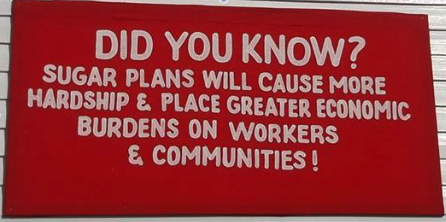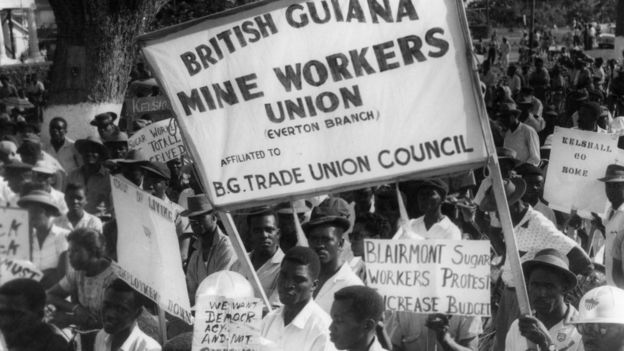Two years into the rule of Guyana’s A Partnership for Unity/Alliance for Change (APNU-AFC) coalition government, the “Good Life” promised on the campaign trail has not come to fruition for the masses of Guyanese people. One enduring feature of Guyana’s society, which underpins this lack of progress, is the racial divide between Indo-Guyanese and Afro-Guyanese .
The government formally acknowledges this divide and through the Ministry of Social Cohesion seeks to heal it, however, the government’s vision of social cohesion sees former President Burnham as the “Father of Social Cohesion.” A cursory look at Guyana’s history shows that Burnham was the chief architect in the split within the multi-racial People’s Progressive Party (PPP) and his rule of Guyana from 1966 until his death in 1985 led to deep political divisions which took on racial overtones as his party, the People’s National Congress (PNC) came to be supported almost exclusively by Afro Guyanese while the PPP was supported almost exclusively by Indo-Guyanese.
Not only is the coalition government’s vision of social cohesion out of touch with the reality of Guyanese history, the practice of the government while in power, has led to the reinforcement of the racial divisions within the country. Nowhere is this more apparent than in the treatment of Guyana’s sugar workers. As the S.W.A previously explained,
“The APNU-AFC government and President Granger are not currently bold enough to try to privatize the government industries all at once; instead they chip away at them little by little. The chisel has fallen hardest on the sugar workers because the government feels that they are not risking the loss of political support from Indo-Guyanese sugar workers and their unions who are traditionally supporters of the opposition People’s Progressive Party.”
As result, as the sugar workers fight to stop the government’s plan to shut down the sugar industry, they have been left isolated from other sectors of the Guyanese masses. The coalition government has pushed the narrative that the country is suffering economically because of the subsidies paid to the sugar industry to keep it afloat and Guyanese people who support the current government have been unsympathetic with the struggle of the sugar workers as a result.

The coalition government is in fact exploiting racial and political divisions while masquerading under the theme of social cohesion. The divisions, however, are not purely the work of the ruling party, the PPP has also had a significant role to play in upholding these racial divisions. For example, in July of 2016 the PPP’s leader and former president Bharrat Jagdeo made false allegations of racism against Indo-Guyanese,
“…there’s an assault on our democracy, there’s an assault on people of Indian origin, there’s an assault on supporters of the PPP (People’s Progressive Party). What we thought would never return to Guyana, in just one short year has returned with full force, and even worse in some regards than the Burnham era.”
To this day Jagdeo has been unable to substantiate those remarks to show where there have been attacks on Indo-Guyanese people or supporters of his party. This is significant not just because it shows the opposition party engaging in racial politics, but because the main target of the APNU/AFC government’s austerity attacks, the sugar workers, are organized by the Guyana Agricultural Workers Union, whose leaders and members are strong supporters of the PPP. In the recent past GAWU has referred to Jagdeo as both a “comrade” and the “champion of the people.”
If Jagdeo is a champion of the Guyanese people, then the implication is that he is champion of Indo-Guyanese people only since he is willing to throw other Guyanese people under the bus by making false allegations of attacks on Indians and the PPP. While it is regrettable that the masses of Guyanese have not rallied to their cause, the sugar workers association with Jagdeo and the PPP certainly provides an explanation. It was Jagdeo after all who presided over Guyana as its government was infiltrated at the highest levels with drug money, which led to the creation of death squads, which targeted and summarily executed Afro-Guyanese young men.
In the fog of the pipe dream of social cohesion pushed the current government and the racial politics of the PPP, the ideas of the Guyanese revolutionary Walter Rodney are a beacon which show the way forward through racial strife. According to Rodney,
“The principal task of our generation is to break the division in the ranks of the working class. To create a unity based on struggle, not a hypothetical unity, or a theoretical unity, but a unity based on struggle.”
It has been 37 years since the assassination of Rodney in 1980 during the reign of the PNC, which currently leads the coalition government, however, Rodney’s words are as true today as they were then. Overcoming the racial divide in Guyana cannot be achieved simply through mealy-mouthed appeals for unity, but through practical unity of the working people united in struggle against the common enemy. It is through such struggles that the Guyanese masses have been able to win their demands for economic and social betterment.
From the times of colonialism to the present day, the prospect of a militant, united and multi-racial Guyanese working class has sent shivers through the rulers of the country. The colonial planter class openly celebrated racial divisions saving them from ruin during strikes and in the 1950s the British sought to accelerate the racial divide within the multi-racial PPP in the anti-colonial struggle. Indo-Guyanese sugar workers and Afro-Guyanese bauxite miners marched side by side not just in the anti-colonial struggle against the British but also against the PNC government in the late 1980s/early 1990s when the PNC began to implement austerity measures.

Today, as thousands of sugar workers stand to lose their jobs, Guyanese workers in other nationalized industries, especially the bauxite workers should rally to their cause. However, given the current political situation this is unlikely. It is then incumbent upon the sugar workers to reach out to other workers suffering under the government’s cutbacks. School cleaners, for example, have recently staged protests to highlight that as the back to school season approaches, the cleaners, who are predominantly Black women, do not have the ability to afford uniforms and supplies for their own children because they are paid below the minimum wage, do not get paid in the summer months and are not afforded pension contributions.
If the sugar workers were to take up the struggle of the school cleaners, they would be bringing Rodney’s ideas to life and showing how workers united in struggle can begin to dispel the racist notions of each other on which the PPP and coalition government rely. Accomplishing this task requires building a political alternative to Guyana’s traditional ruling parties. The Socialist Workers Alliance seeks to build such an organization which can serve as a voice for working people of all racial backgrounds, united in struggle, join us.
